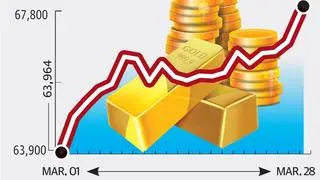Aluminium prices are expected to move up over the next six months — with increasing levels of air pollution in China working in favour of prices.
China, which accounts for nearly 54 per cent of the 58.9 million tonne (mt) global aluminium production, is expected to close down some of its highly polluting production centres over the next five years as part of its National Air Pollution Plan.
Prices have moved up about 16 per cent over the last seven months, between August 2016 and March 2017. The metal is currently trading at $1,946 per tonne on the LME. The revival in US manufacturing over the last four months and healthy auto sales, both in the US and China, in 2016 are positives for the metal’s short-term and long-term prospects.
Cheer in the airThe landmark OPEC deal to cut crude oil production and stabilise oil prices, an economic growth rate of 6.7 per cent in China in 2016, the Trump government’s thrust on infrastructure spending, the Federal Reserve’s intention to push through two more revisions in 2017 indicate that the global economy might not have too many hiccups in the year ahead.
Besides, US manufacturing has expanded consistently between November 2016 and February 2017, compared to the same period a year earlier.
China’s anti-pollution driveAlso, as indicated earlier, China’s plan to cut air pollution drastically over the next five years should boost aluminium prices.
According to Rusal, a major Russian aluminium producer, this plan will decrease pollution intensity in Beijing and the neighbouring regions of Hebei, Shandong, Shanxi, Henan and Tianjin. Together, these regions, with emission intensity four times the national average, consume 33 per cent of coal produced in China, 39 per cent of total aluminium production and 79 per cent of total alumina production. As per the plan, 30 per cent of the aluminium smelting capacity in Beijing and surrounding areas is expected to be closed every year.
With a possible drop in production due to these changes and the demand for aluminium remaining intact, we can expect China to import alumina in the short run, thus keeping up global aluminium prices. Also, the cost of alumina, an important factor of production of aluminium, has increased about 75 per cent over the last one year.
Contrary to expectations, there was no slowdown in aluminium demand in China in 2016 and inventory build-up was also avoided. For the year 2017, Alcoa expects the global aluminium market to end up with a modest surplus of 0.4 to 0.8 mt.
Steady long-term outlookThe long-term demand for aluminium continues to remain robust. Rusal estimates global demand to grow 6.2 per cent in 2017, mainly driven by the transportation and construction sectors, which constitute about 40 and 20 per cent of demand, respectively. Of the total global demand forecast in 2017, demand from China constitutes nearly 70 per cent.
Also, of this demand from China, close to 35 per cent is contributed by the transportation sector, which is expected to grow more than 10 per cent in 2017.
According to the China Association of Automobile Engineers, passenger car sales in 2016 in China stood at around 24.4 million, about 15 per cent greater than the year earlier. Similarly, according to Autodata, US car and truck sales for 2016 are at 17.6 million in 2016, compared to 17.5 million in 2015.
The US, China and Europe constitute close to 70 per cent of the global automobile market. The stringent emission norms in these countries and the decision by auto companies to progressively increase the proportion of aluminium products in place of steel products will keep demand robust in the long run. The construction sector is also seeing a strong pick-up in the US and China.








Comments
Comments have to be in English, and in full sentences. They cannot be abusive or personal. Please abide by our community guidelines for posting your comments.
We have migrated to a new commenting platform. If you are already a registered user of TheHindu Businessline and logged in, you may continue to engage with our articles. If you do not have an account please register and login to post comments. Users can access their older comments by logging into their accounts on Vuukle.